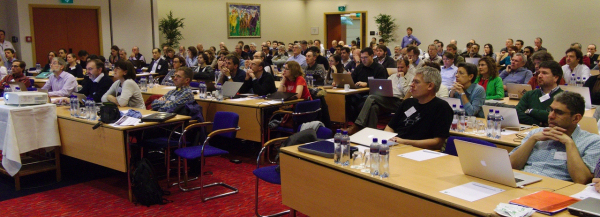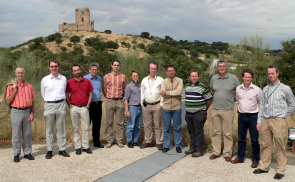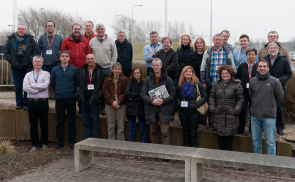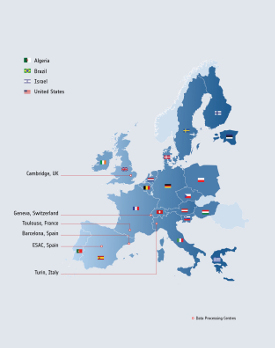Making sense of it all – the role of the Gaia Data Processing and Analysis Consortium
The transformation of the raw measurements takes place within the DPAC Coordination Units, or CUs. Each unit is responsible for developing the scientific algorithms and software corresponding to particular, well-defined aspects of the data processing and analysis.
 |
|
| DPAC consortium meeting, November 2015. Image courtesy of A. Brown | |
 |
 |
| Members of Gaia DPACE, September 2006. Credit: ESA/ W. O'Mullane | DPACE and GST members, February 2015. Credit: ESA/ W. O'Mullane |
Two units provide development support for technical aspects such as defining the software architecture and strategy (CU1), and for the data simulations (CU2) that have been essential for preparing for the real mission data by allowing DPAC to test their software and rehearse the science operations.
Three units are responsible for basic data processing. The CU3 unit takes care of processing astrometric data, which provides the positions and motions of celestial bodies in the sky. Photometric data processing, which results in a measure of how much light is emitted by the objects, is the task of CU5. The spectroscopic data processing, carried out by CU6, produces a measure of the velocity with which an object is moving towards or away from us, and what the star is made of.
Three units examine particular aspects of the processed data, looking at Solar System objects, double stars, orbital binaries, exoplanets, and extragalactic objects (CU4); variable stars (CU7); and classification and characterization of all of the celestial objects observed by Gaia (CU8).
One unit (CU9) is responsible for the preparation, validation and distribution of the intermediate data releases and final Gaia catalogue.
The software developed by each of the CUs is run in one of the six data processing centres located in France (Toulouse), Italy (Turin), Spain (ESAC, near Madrid; Barcelona), Switzerland (Geneva), and the United Kingdom (Cambridge). These centres host the computing hardware and provide software engineering expertise to support the CU software development work.
 |
| DPAC members come from 20 European countries and from further afield. |
The DPAC is funded through national funding agencies of the participating ESA member states. These funding agencies have signed a multilateral agreement with ESA that commits all parties to fund the DPAC effort up to the completion of the final Gaia catalogue, expected in the early 2020s. In addition, ESA makes a significant contribution to DPAC in the form of the Data Processing Centre at the European Space Astronomy Centre (ESAC) in Spain, which amongst other tasks and responsibilities, acts as the central hub for all Gaia data processing.
The final Gaia catalogue, to be produced by DPAC and ESA, will contain positions, distances, and motions for more than one billion celestial objects. For each of these objects Gaia will tell us the temperature, where it is in its lifecycle, the composition, and what lies between us and that object. There will be stars from every phase of the stellar lifecycle, as well as asteroids in our Solar System and planets around other stars. There will also be objects located beyond the Milky Way, such as other galaxies and quasars – distant sources that are used to construct the reference frame used for celestial coordinates.







